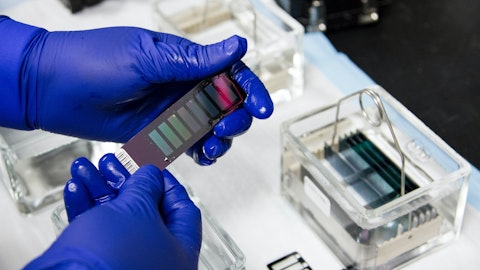Enanta Pharmaceuticals, Inc. (NASDAQ:ENTA) Q4 2023 Earnings Call Transcript November 20, 2023
Enanta Pharmaceuticals, Inc. beats earnings expectations. Reported EPS is $-1.33, expectations were $-2.11.
Operator: Good afternoon, and welcome to Enanta Pharmaceuticals Fiscal Fourth Quarter and Year-End Financial Results Conference Call. At this time, all participants are in a listen-only mode. There will be a question-and-answer session at the end of the prepared remarks. Please be advised that this call is being recorded. I would now like to turn the conference to your host Ms. Jennifer Viera, Investor Relations. Please go ahead.
Jennifer Viera: Thank you, operator, and thanks to everyone for joining us this afternoon. The news release with our fiscal fourth quarter and year-end 2023 financial results was issued this afternoon and is available on our website. Making formal remarks on today’s call are Dr. Jay Luly, President and Chief Executive Officer; and Paul Mellett, our Chief Financial Officer. Dr. Scott Rottinghaus, our Chief Medical Officer; and Dr. Tara Kieffer, our Senior Vice President of New Product Strategy and Development, will be available during the Q&A portion of the call. Before we begin with our formal remarks, we want to remind you that we will be making forward-looking statements, which may include our plans and expectations with respect to our research and development pipeline and financial projections, all of which involve certain assumptions and risks beyond our control that could cause our actual developments and results to differ materially from those statements.
A description of these risks is in our most recent Form 10-K and other periodic reports filed with the SEC. Enanta does not undertake any obligation to update any forward-looking statements made during the call. With that, I’d now like to turn the call over to Dr. Jay Luly, President and CEO. Jay?
Jay Luly: Thank you, Jennifer, and good afternoon, everyone. In fiscal 2023, Enanta took important steps leading to meaningful progress in addressing the unmet need for treating serious respiratory viruses and advancing our business objectives. As we look toward the future, we continue to assess opportunities that will leverage our expertise to transform the lives of patients by discovering novel treatments for viral infections and other diseases. 2024 is shaping up to be an important year for us with multiple inflection points expected, including potential growth into new therapeutic areas. Today, I’ll provide an overview of our progress during the fourth quarter beginning with our respiratory syncytial virus, or RSV, program, and then I will comment on the rest of our pipeline and give a business update.
RSV is a severe respiratory infection associated with significant morbidity and mortality that can cause serious disease in infants, children and other high-risk populations, including the elderly and individuals with congestive heart failure, chronic obstructive pulmonary disease or asthma. There remains a significant unmet need for RSV treatments despite the availability of vaccines and prophylactic monoclonal antibodies that reduce the risk of infection for some high-risk populations. Vaccines will inevitably have a suboptimal uptake. And as we’ve seen with other respiratory viruses, even with adoption, breakthrough infections will still occur. Further, while monoclonal antibodies can provide short-term passive immunity for infants, they will only shift the infant’s first infection to the next season.
We aim to fill this unmet need for an RSV treatment through the advancement of our broad RSV program, which includes EDP-938, the only N-protein inhibitor in clinical development and EDP-323, an L-protein inhibitor, both of which have Fast Track designation from the FDA. As such, we are evaluating EDP-938 in two Phase 2 studies, RSVPEDs and RSVHR as a potential treatment in high-risk patient populations. RSVPEDs is a Phase 2 randomized, double-blind, placebo-controlled study in approximately 90 hospitalized and non-hospitalized pediatric patients with RSV aged 28 days to 36 months. It’s a two-part study. Because this is the first time the drug is being dosed in pediatrics, the objective of the first part of the study is to evaluate the safety and pharmacokinetics of EDP-938 in multiple ascending doses in order to select the optimal dose for each age group.
The objective of the second part of the study is to evaluate the antiviral activity of EDP-938 at the selected optimal dose. It was designed as a small cohort to show a trend toward improved virology metrics for EDP-938 compared to placebo and to give confidence to move forward efficiently into registrational studies. Additionally, we will evaluate symptom scores assessed through the treatment duration. RSVHR is a Phase 2b randomized, double-blind, placebo-controlled study in adults with RSV infection who are at high risk of complications, including the elderly and individuals with congestive heart failure, chronic obstructive pulmonary disease or asthma. Approximately 180 patients will be treated with 800 milligrams of EDP-938 or placebo for five days and evaluated over a 28-day period thereafter.
The primary endpoint of RSVHR is time to resolution of RSV lower respiratory tract disease symptoms as assessed by the Respiratory Infection Intensity and Impact Questionnaire, or RIIQ, symptom scale. Secondary endpoints include additional clinical efficacy measures and antiviral activity compared to placebo as well as pharmacokinetics and safety of EDP-938. In this study, we will be looking for an improvement in time to symptom resolution, our primary endpoint, as well as effects on other secondary endpoints such as antiviral activity. Both studies continue to enroll throughout the global footprint with RSVPEDs having over 75 sites across 15 countries and RSVHR over 130 sites across 16 countries. Our goal continues to be completion of enrollment in at least one of these EDP-938 studies with topline data in the third quarter of 2024, assuming we will return to a normal pre-pandemic type of RSV season in the Northern Hemisphere.
We are still early in that season, but initial data are consistent with a more normal season. Also advancing our leadership in RSV, today, we announced the initiation of our Phase 2a challenge study of EDP-323, an L-protein inhibitor in development as a once-daily oral treatment for RSV. In this randomized, double-blind, placebo-controlled study, up to 114 healthy adult subjects will be infected with the RSV-A Memphis 37b virus and then randomized 1:1:1 to receive once daily dosing of either 600 milligrams of EDP-323, 200 milligrams of EDP-323 with a loading dose of 600 milligrams on the first day or placebo for five days. Primary and secondary outcome measures include safety, changes in viral load measurements and changes in baseline symptoms.
We plan to report data from this study in the third quarter of 2024. The advancement of EDP-323 is supported by positive Phase 1 results in which EDP-323 demonstrated favorable safety, tolerability and pharmacokinetics in healthy volunteers. We believe either EDP-938 or 323 would be effective as a monotherapy, but because the mechanism of action of each is different, we also have the opportunity to use them in combination. Preclinically, the combination of EDP-938 and EDP-323 has additive to synergistic activity. A combination approach would allow us to explore potentially broadening the treatment window or providing additional benefit and specific harder-to-treat populations. In hepatitis B, we believe we need an additional mechanism to develop in combination with EDP-514, our potent core inhibitor with FDA Fast Track designation.

We think a core inhibitor such as EDP-514 could ultimately be an important component of a successful combination regimen and potentially help us address the high level of unmet need in chronic HBV. I’d like to take a moment to acknowledge that we have made important adjustments to our business this year to significantly reduce our 2024 spending and extend our cash runway through fiscal 2027, which Paul will cover in a moment. As previously disclosed, we made the decision to stop RSVTx, our Phase 2 study in adult hematopoietic cell transplant recipients with RSV infection. We felt it prudent to concentrate our efforts and resources on our pediatric and high-risk adult studies, which comprise the largest patient populations with unmet need and represent the faster paths to market.
Furthermore, we made the decision to pause our hMPV/RSV dual-inhibitor program. While the dual-inhibitor has shown significant promise preclinically, we do not plan to move a third RSV compound into the clinic as long as our other two more advanced candidates continue to progress. And as we’ve mentioned before, we intend to conduct all future work in COVID-19 in the context of a collaboration. These changes allow us to reallocate our focus and resources to diversify our portfolio into other disease areas. We believe this path forward best aligns with our long-term goal at Enanta to deliver highly differentiated therapeutics through innovative chemistry and positions us to provide significant value to patients and our shareholders. To that end, we are excited about the expansion of our research efforts into non-virology indications that leverage our core strength in small molecule drug discovery.
We look forward to providing more insight into our progress and announcing new therapeutic programs starting in early 2024. With that, I’d like to wrap up by highlighting our near-term milestones. We look forward to reporting results from our Phase 2a challenge study of EDP-323 in the third quarter of 2024. And assuming there is a return to a normal pre-pandemic type of RSV season in the Northern Hemisphere, we expect to complete enrollment in one or both of our Phase 2 studies of EDP-938 and to have data in the third quarter of 2024. Finally, we will announce new non-virology therapeutic programs beginning in early 2024. Now, I’ll turn the call over to Paul to discuss our financials. Paul?
Paul Mellett: Thank you, Jay. I’d like to remind everyone that Enanta reports on a September 30 fiscal year schedule. Today, we are reporting results for our fourth quarter and full year ended September 30, 2023. For the quarter, total revenue was $18.9 million and consisted of royalty revenue earned on AbbVie’s global MAVYRET net product sales. This compares to total revenue of $20.3 million for the same period in 2022. For the 12 months ended September 30, 2023, total revenue was $79.2 million compared to $86.2 million for the same period in 2022. The decrease in the quarter and year-over-year revenue is due to a decline in AbbVie sales of MAVYRET. Beginning in the quarter ended September 30, 2023, 54.5% of Enanta’s ongoing royalties from AbbVie’s net sales of MAVYRET that are included in our revenue are being paid to OMERS, one of Canada’s largest defined benefit pension plans pursuant to a royalty sale transaction in April 2023.
For financial reporting purposes, the transaction was treated as debt with the upfront purchase payment to us of $200 million recorded as a liability. Enanta will continue to record 100% of the royalties earned as revenue and will then amortize the debt liability proportionately as 54.5% of the cash royalty payments are paid to OMERS, until a cap of 1.42 times the purchase payment is met, after which point, 100% of the cash royalty payments will be retained by Enanta. Non-cash interest expense for the debt will be recorded in Enanta’s consolidated statement of operations as a non-operating expense based on an imputed interest rate. Interest expense was $3.2 million for the three months ended September 30, 2023, and $5.1 million for the 12 months ended September 30, 2023.
Moving now to our operating expenses. For the three months ended September 30, 2023, research and development expenses totaled $36.2 million compared to $34.8 million for the same period in 2022. The slight increase was due to an increase in the timing of clinical trial costs, offset by a decrease in preclinical and manufacturing costs. For the 12 months ended September 30, 2023, research and development expenses were $163.5 million compared to $164.5 million in 2022. General and administrative expenses totaled $13.8 million for the three months ended September 30, 2023, compared to $12.6 million for the three months ended September 30, 2022. For the 12 months ended September 30, 2023, general and administrative expenses were $52.9 million compared to $45.5 million in 2022.
The increases in both periods were primarily due to an increase in legal fees related to our patent infringement suit against Pfizer. Other income net totaled $4.7 million for the three months ended September 30, 2023, compared to $0.7 million for the three months ended September 30, 2022. For the 12 months ended September 30, 2023, other income net totaled $11.4 million compared to $1.7 million in 2022. The increases in both periods were primarily due to an increase in investment income due to an increase in our average invested cash balance from the receipt in April ’23 of $200 million from the sale of our MAVYRET royalty as well as increases in interest rates year-over-year. Enanta recorded an income tax benefit of $1.4 million for the three months ended September 30, 2023, compared to an income tax expense of less than $0.1 million for the three months ended September 30, 2022.
Enanta recorded an income tax expense of $2.8 million for the 12 months ended September 30, 2023, compared to an income tax benefit of $0.4 million for the 12 months ended September 30, 2022. Despite recording a financial reporting loss before taxes during the 12 months ended September 30, 2023, we recorded tax expense driven by the receipt of the $200 million from the royalty sale agreement, which is treated as income for federal and state income tax purposes. This taxable income and its related income tax expense was substantially offset by net operating loss carryforwards, research and development tax credit carryforwards and a deduction for foreign-derived intangible income. Net loss for the three months ended September 30, 2023, was $28.1 million or a loss of $1.33 per diluted common share compared to a net loss of $26.3 million or a loss of $1.27 per diluted common share for the corresponding period in 2022.
For the 12 months ended September 30, 2023, net loss was $133.8 million or a loss of $6.38 per diluted common share compared to a net loss of $121.8 million or a loss of $5.91 per diluted common share for the corresponding period in 2022. Enanta ended the quarter with approximately $370 million in cash and marketable securities. We expect that our current cash, cash equivalents and short-term marketable securities as well as our ongoing retained portion of royalties will continue to be sufficient to meet the anticipated cash requirements of our existing business and development programs through fiscal 2027. Regarding guidance for fiscal ’24, we expect our research and development expense to be between $100 million and $120 million, and our general and administrative expense to be between $45 million and $50 million.
This is reduced from research and development expense of $163.5 million and general and administrative expense of $52.9 million in fiscal 2023. This general and administrative expense includes an increase in legal fees associated with our patent infringement suit against Pfizer. Further financial details are included in our press release and will be available in our annual report on Form 10-K when filed. I’d now like to turn the call back to the operator and open up the lines for questions. Operator?
See also Billionaire Steven Cohen’s Top High Dividend Stock Picks and 18 Countries That Need Doctors in 2023.
Q&A Session
Follow Enanta Pharmaceuticals Inc (NASDAQ:ENTA)
Follow Enanta Pharmaceuticals Inc (NASDAQ:ENTA)
Operator: Thank you. [Operator Instructions] Our first question comes from the line of Roanna Ruiz of Leerink Partners. Your line is open.
Roanna Ruiz: Hi. Afternoon, everyone. So, I wanted to ask about one of your RSV programs for 323 with the challenge study. I was curious, assuming that’s successful, how fast could you proceed to Phase 3? And what sort of measures are you considering for a Phase 3 design like symptoms or virology endpoints?
Jay Luly: Hi, Roanna, this is Jay. So, we’re aiming, as we said on the call, to finish up the challenge study and to report out data in Q3. There’s obviously some other things we would need to do in terms of preparedness for phase — well, beyond the challenge study, let’s just say that. And I think what we’re going to do is simultaneously be watching the 938 studies and learning ultimately from hopefully, at least one of those data sets in PEDs or HR, to help inform the development path of how we’re thinking about 323 going forward. So, it’s a little bit premature. I want to also take a peek at the data from the challenge study. Again, it’s a very, very potent molecule. It’s got a great PK. We’ve set up a couple of different dosing regimens, both of which are effectively QD.
One is the high dose QD and then the other is a loading dose on day one QD followed by a lower dose on these 235. So, we’ll get the aggregate of the data, look at it and see how it compares to 938 and the challenge study, at least as best we can compare to challenge studies. And then, thinking a lot about how we position either of these in the market. We think that either of them could be used as a single agent, but they also since they have different mechanisms to potentially be used in combination. There’s no cross resistance and I think we would have a good barrier to resistance under the way we’re — the way we chose the mechanisms and dosing them. So, lots of different kinds of options but a little bit premature to talk about 323 too far down the line.
Roanna Ruiz: Yes. Understood. And my second question, I just wanted to ask about the dual-inhibitor program for human metapneumovirus and RSV. I was curious, is the pause in development there? Is it more just to prioritize your other more later-stage RSV trials? Or was there any new data that informed this decision?
Jay Luly: No. The data — I mean, the data continued to look really interesting in terms of the profile. As we think about it, again, we’ve got a fair number of things on our plate right now, but we’ve got two more advanced RSV molecules moving ahead well in development. And the dual — when you distill it down, yes, it hits human metapneumo, which we do think is an advantage. Human metapneumo is a fraction of the market of RSV. It’s not an insignificant fraction, but it’s still a fraction. I think RSV — having RSV in that dual is very, very important because RSV is a big piece of what that market would look like anyway. And when we sort of step back and looked at our current ongoing studies and the resources involved, we have two that are moving along very nicely for the large piece of the overall market, which is obviously RSV.
So, I think we’ll — we still have some light activities, sort of smoldering on that. But I think the key focus is going to be watching at our two lead horses, that clinical data come out. And then we’ve always got that molecule in our back pocket in reserve.
Roanna Ruiz: Got it. Thanks.
Jay Luly: You’re welcome.
Operator: Thank you. One moment, please. Our next question comes from the line of Jay Olson of Oppenheimer. Your line is open.
Jay Olson: Thanks for taking the question. And recognizing that it’s early, maybe just a follow-up on 323. I guess what are you hoping to see in the Phase 2a challenge study? What extent of viral load reduction would be clinically meaningful? And how do you plan to differentiate 323 from 938? Thank you.
Jay Luly: Thanks, Jay. This is Jay. I always look forward to saying that once a quarter. So, I think the challenge study is nice because it’s been run against different classes of compounds. It’s been done substantially in the same way across different classes. We’ve got a very strong data set with EDP-938 that serves us a certain standard internally anyway to compare data to. So, the type of data that you would get from that is you look at both virology and symptoms. So you look at — and it’s really compared against placebo, right? So, everyone is infected, inoculation day, so to speak. You wait for the viral loads to begin to build, and that happens variously on a different day for one person versus another. But once you start to register viral loads, the next day you begin dosing, right?
And so what we found, at least with 938 was almost immediately upon dosing, you changed the trajectory of the infection. So, people who are dosed with placebo, viral loads continue to rise, they peak and then they gradually decline over a period of many days. People who are dosed with our test agent, you see viral loads basically stopped in their tracks and in fact, are pushed downward rapidly. So, what that allows you to do is compare the area under the curve of drug treatment versus placebo. And we’ve put very strong numbers on the boards with EDP-938, it was I think in the 70%s reduction in the AUC. Simultaneously, you’re tracking symptom scores and you’re looking at a composite of multiple different symptoms. And it’s pretty much the same graph.




